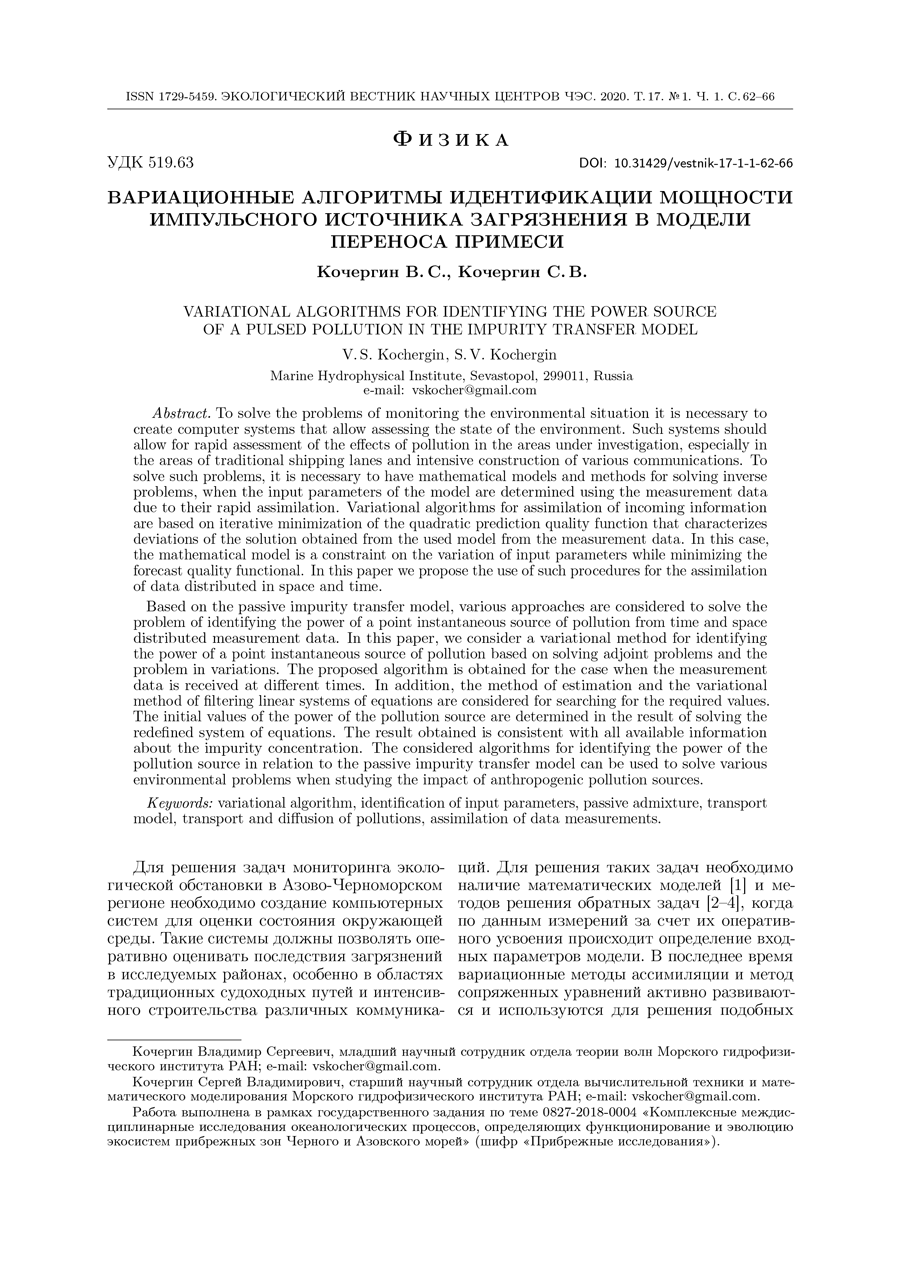Variational Algorithms for Identifying the Power Source of a Pulsed Pollution in the Impurity Transfer Model
UDC
519.63DOI:
https://doi.org/10.31429/vestnik-17-1-1-62-66Abstract
To solve the problems of monitoring the environmental situation it is necessary to create computer systems that allow assessing the state of the environment. Such systems should allow for rapid assessment of the effects of pollution in the areas under investigation, especially in the areas of traditional shipping lanes and intensive construction of various communications. To solve such problems, it is necessary to have mathematical models and methods for solving inverse problems, when the input parameters of the model are determined using the measurement data due to their rapid assimilation. Variational algorithms for assimilation of incoming information are based on iterative minimization of the quadratic prediction quality function that characterizes deviations of the solution obtained from the used model from the measurement data. In this case, the mathematical model is a constraint on the variation of input parameters while minimizing the forecast quality functional. In this paper we propose the use of such procedures for the assimilation of data distributed in space and time.
Based on the passive impurity transfer model, various approaches are considered to solve the problem of identifying the power of a point instantaneous source of pollution from time and space distributed measurement data. In this paper, we consider a variational method for identifying the power of a point instantaneous source of pollution based on solving adjoint problems and the problem in variations. The proposed algorithm is obtained for the case when the measurement data is received at different times. In addition, the method of estimation and the variational method of filtering linear systems of equations are considered for searching for the required values. The initial values of the power of the pollution source are determined in the result of solving the redefined system of equations. The result obtained is consistent with all available information about the impurity concentration. The considered algorithms for identifying the power of the pollution source in relation to the passive impurity transfer model can be used to solve various environmental problems when studying the impact of anthropogenic pollution sources.
Keywords:
variational algorithm, identification of input parameters, passive admixture, transport model, transport and diffusion of pollutions, assimilation of data measurementsAcknowledgement
References
- Ivanov, V.A.. Fomin, V.V. Matematicheskoye modelirovaniye dinamiche-skikh protsessov v zone more – susha [Mathematical modeling of dynamic processes in the sea–land zone]. EKOSI-gidrofizika, Sevastopol, 2008. (In Russian)
- Marchuk, G.I., Penenko, V.V. Application of optimization methods to the problem of mathematical simulation of atmospheric processes and environment. In: Marchuk G.I. (ed.) Modelling and Optimization of Complex Systems. Proc. of the IFIP-TC7 Working conf.. Springer, New York, 1978, pp. 240–252.
- Kochergin, V.S., Kochergin, S.V. Ispol'zovanie variacionnyh princi-pov i resheniya sopryazhennoj zadachi pri identifikacii vhodnyh parametrov modeli perenosa passivnoj primesi [Using variational principles and solving a conjugate problem in identifying the input parameters of a passive admixture transport model]. Ekologicheskaya bezopasnost' pribrezhnoj i shel'fovoj zon i kompleksnoe ispol'zovanie resursov shel'fa, Ecological safety of coastal and shelf zones and integrated use of shelf resources], 2010, no. 22, pp. 240–244. (In Russian)
- Penenko, V.V. Metody chislennogo modelirovaniya atmosfernykh protsessov [Methods of numerical modeling of atmospheric processes]. Gidrometeoizdat, Leningrad, 1981. (In Russian)
- Agoshkov, V.I., Parmuzin, E.I., Shutyaev, V.P. Assimilyaciya dannyh nablyudenij v zadache cirkulyacii CHernogo morya i analiz chuvstvitel'nosti eyo resheniya [Assimilation of observational data in the Black Sea circulation problem and analysis of the sensitivity of its solution]. Izvestiya RAN. Fizika atmosfery i okeana [Bulletin of the Russian Academy of Sciences. Physics of the atmosphere and the ocean], 2013, vol. 49, no. 6, pp. 643–654. (In Russian)
- Shutyaev, V.P., Le Dime, F., Agoshkov, V.I., Parmuzin, E.I. Chuvstvitel'nost' funkcionalov zadach' variacionnogo usvoeniya dannyh nablyudeni [Sensitivity of functionals task of variational assimilation of observational data]. Izvestiya RAN. Fizika atmosfery i okeana [Bulletin of the Russian Academy of Sciences. Physics of the atmosphere and the ocean], 2015, vol. 51, no. 3, pp. 392–400. (In Russian)
- Shutyaev, V.P., Le Dimet, F.-X., Parmuzin, E. Sensitivity analysis with respect to observations in variational data assimilation for parameter estimation. Nonlinear processes in Geophysics, 2018, vol. 25, iss. 2, pp. 429–439.
- Kochergin, V.S., Kochergin, S.V. Indentification of a pollution source power in the Kazantip bay applying the variation algorithm. Physical Oceanography, 2015, no. 2, pp. 69–76.
- Kochergin, V.S., Kochergin, S.V. Variacionnye algoritmy identifikacii moshchnosti tochechnogo impul'snogo istochnika zagryazneniya [Variational algorithms for identifying the power of a point pulse source of pollution]. Ekologicheskij vestnik nauchnyh centrov CHernomorskogo ekonomicheskogo sotrudnichestva [Ecological Bulletin of Scientific Centers of the Black Sea Economic Cooperation], 2017, no. 3, pp. 62–72. (In Russian)
- Marchuk, G.I. Matematicheskoye modelirovaniye v probleme okruzhayushchey sredy [Mathematical modeling in the environmental problem]. Nauka, Moscow, 1982. (In Russian)
- Kochergin, V.S. Opredelenie polya koncentracii passivnoj primesi po nachal'nym dannym na osnove resheniya sopryazhennyh zadach [Determination of the concentration field of the passive admixture from the initial data on the basis of solving related problems]. Ekologicheskaya bezopasnost' pribrezhnoj i shel'fovoj zon i kompleksnoe ispol'zovanie resursov shel'fa [Ecological safety of the coastal and shelf zones and the integrated use of shelf resources], 2011, no. 25, vol. 2, pp. 270–376. (In Russian)
- Strahov, V.N. Metod fil'tracii sistem linejnyh algebraicheskih uravnenij – osnova dlya resheniya linejnyh zadach gravimetrii i magnitometrii [The method of filtering systems of linear algebraic equations – the basis for solving linear problems of gravimetry and magnetometry]. Doklady AN SSSR [Reports of the USSR Academy of Sciences], 1991, vol. 320, no. 3, pp. 595–599. (In Russian)
- Eremeyev, V.N.. Kochergin, V.P.. Kochergin, S.V.. Sklyar, S.N. Matematicheskoye modelirovaniye gidrodinamiki glubokovdnykh basseynov [Mathematical modeling of hydrodynamics of deep-water basins]. EKOSI-Gidrofizika, Sevastopol, 2002. (In Russian)
Downloads
Submitted
Published
How to Cite
Copyright (c) 2020 Kochergin V.S., Kochergin S.V.

This work is licensed under a Creative Commons Attribution 4.0 International License.




